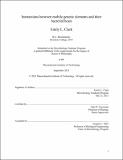Interactions between mobile genetic elements and their bacterial hosts
Author(s)
Clark, Emily L.
DownloadThesis PDF (3.479Mb)
Advisor
Grossman, Alan D.
Terms of use
Metadata
Show full item recordAbstract
Integrative and conjugative elements (ICEs) are widespread mobile genetic elements that facilitate the spread of many important genes, including those involved in antibiotic resistance, metabolism, pathogenesis, or symbiosis. These elements are also powerful tools for genetic analyses and engineering. ICEs are typically found integrated in a host chromosome. Either stochastically, or upon some signal, they can excise, undergo DNA processing events, be transferred through encoded conjugation machinery into a neighboring cell, and stably integrate into the new chromosome. Interactions between an ICE and its hosts throughout the life cycle can influence the efficiency of acquisition by new hosts. In this work, I investigated and compared the interactions that two ICEs, Tn916 and ICEBs1, have with their host cells. First, I explored how the different functional modules of these elements impact how efficiently they are transferred into different host species. I generated hybrid conjugative elements that merge functions of both elements to increase transfer efficiencies, presenting exciting potential to be used for genetic engineering. Next, I investigated a previously unknown ability of Tn916 to cause a growth arrest and kill its host cell. I took genetic approaches to determine that two Tn916-encoded genes interact with a defective phage-like element in the B. subtilis chromosome to elicit some of these effects. Finally, I evaluated the integration site selection of Tn916 in the B. subtilis chromosome, identifying several hundred unique AT-rich insertion sites, one of which is a “hot spot” for integration. I found that a host nucleoid-associated protein does not influence integration site selection. I conclude this body of work with a discussion of how the efficient spread of an element is shaped by its interactions with host cells and other horizontally acquired elements.
Date issued
2021-09Department
Massachusetts Institute of Technology. Microbiology Graduate ProgramPublisher
Massachusetts Institute of Technology